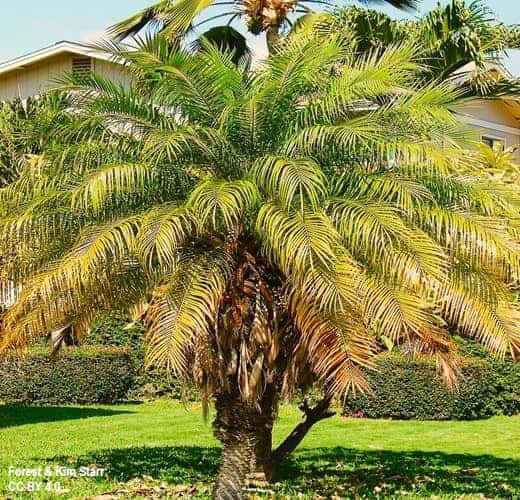- Home
- Palms in U.S.
- Palms in Arizona?
- Best Arizona Palms
Best Palm Trees for Arizona
Choosing the best palm trees for Arizona in the United States, is definitely doable!
Are you seeking to add a touch of deserty tropical flair to your Arizona landscape? Then it's time to turn your attention to evaluating the best palm trees for Arizona.
At Mission: Palm Trees
Palm lovers can soothe their palm-related searches and concerns. Our articles are intended to inform, while having fun, easily Finding What You Want or Need. Without unneeded shoptalk & tiring endless research. We Research For You!
Adapting to Arizona's hot, dry desert areas can be a challenge for many plants, we certainly know - as Tucson Arizona residents.
But certain species of palms thrive in these desert conditions. We see many of these all around town, near our home & in our neighborhood.
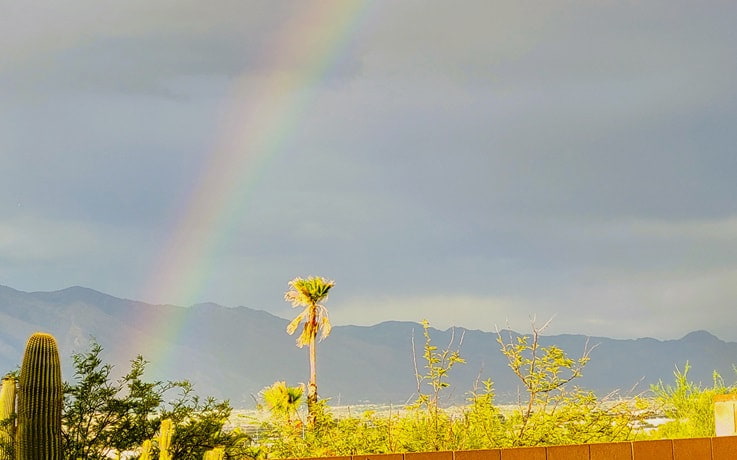 A Palm Glowing Under a Rainbow Formation in our Neighborhood.
A Palm Glowing Under a Rainbow Formation in our Neighborhood.Here's a nice University of Arizona download for Growing Plants in Arizona Zones.
Let's see which ones are the best palm trees for Arizona. Along with helpful best tips for your decision in growing these species of palm trees in Arizona.
See These Best Arizona Palm Trees for Planting
Mule Palm Tree is a Best Landscape Plant for Arizona
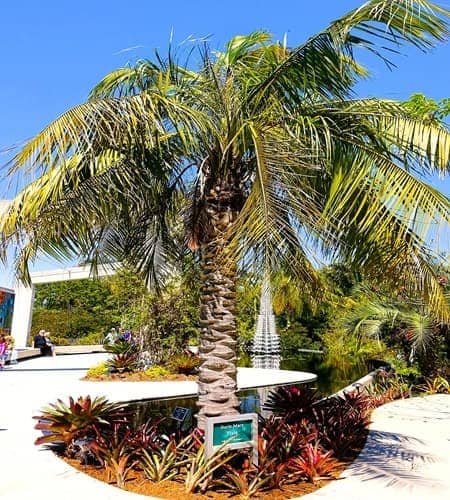 Mule Palm Growing in Naples Botanical Garden
Mule Palm Growing in Naples Botanical GardenThe Mule Palm, the Butia x Syagrus (xButiagrus nabonnandii) creation.
This is a wonderful hybrid palm. A cross between the Pindo Palm and the Queen Palm. Per it's "mule" nickname, it's sterile & can't reproduce. Occasionally, you may see it has Palm Fruit, but nothing grows from the seeds.
Adults will remind you of a Coconut Palm, of course without coconuts!
It takes the best of both of their parent palms.
Like the Queen...
- The growth rate is pretty quick. When Grown From Seed correctly, you'll likely have success.
- It's a suitable Palm for Full Sun.
- It needs ample watering.
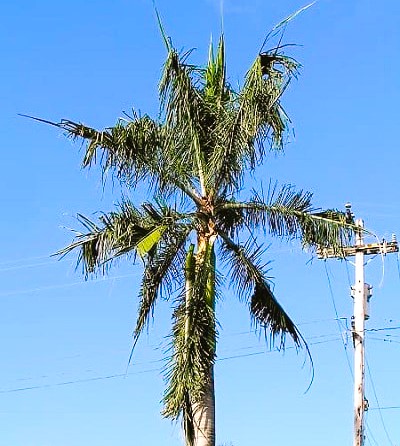 Queen Palm Looking Pretty Scraggly!
Queen Palm Looking Pretty Scraggly!Think it's Suffering From Thirst
Like the Pindo (which on it's own is also a pick for Arizona)...
- It's quite hardy for drought circumstances, especially in a dry climate. But also likes extra rainy days.
- It's not fussy about the soil it's planted in.
- It does very well with full sun, but tolerates partial shade, too.
HERE'S THE PINDO/JELLY...
So, the Mule Palm is one of the best palm trees for Arizona because our arid climate suits it well. And as deserts do, if winter night's cold temperatures sometimes dip low, it can get through it.
They were quite rare, but are now found more often in nurseries & from private sellers. A member of "Palm Talk" has had saplings for sale.
Mexican Fan Palm to Grow in Arizona
Washingtonia robusta is known for its very tall, thin trunk and large, fan-shaped leaves. These are the ones famed in Southern California, Seen All Through Los Angeles. We also see many of them in the Phoenix area.
Before considering one as An Idea for Your Landscape, remember they really are tall - getting to 100 feet/30 meters. So, not recommended for tight spaces. Will it fit appropriately?
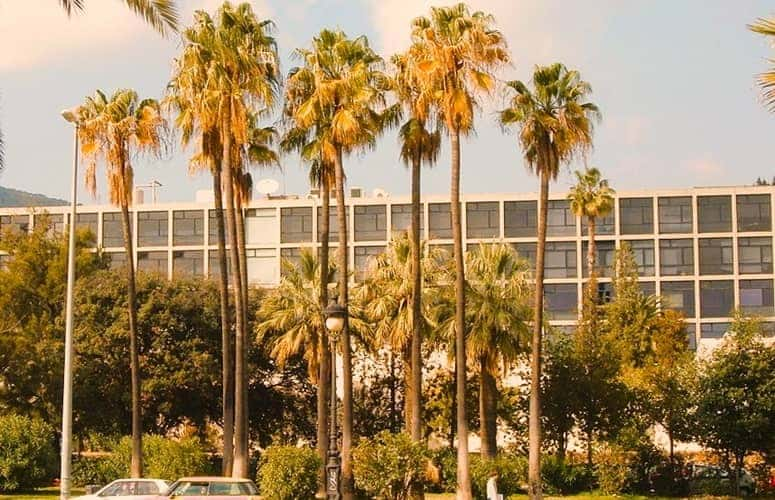 Washingtoni robusta grouping in Barcelona Spain
Washingtoni robusta grouping in Barcelona SpainIts advantages for growing in Arizona are...
- It's suitable for USDA Hardiness Zones 9-11.
- Loves the sun.
- Grows pretty fast. And easily in any well-drained soils.
Yet it does need regular watering while getting established. Then it's drought-hardy.
Filifera Fan Palm is a Keeper in Arizona
Washingtonia filifera has other common names: the California Fan Palm & the Desert Fan Palm. It's the only palm tree native to California, as well as Arizona. So, no surprise it's among the best palm trees for Arizona, able to withstand extreme heat.
It's particularly hardy in Arizona Zones 7-11 & tolerant of drought. Needed maintenance is minimal, with watering according to lower needs. Leaf trimming unnecessary, as it keeps a "frond skirt" for awhile, eventually self-pruning the oldest dead leaves.
For those with enough room (gets 50-70'/15-21m tall), it's a simple choice for Arizona homeowners. Since the Desert Fan Palm can bravely face the Arizona sun.
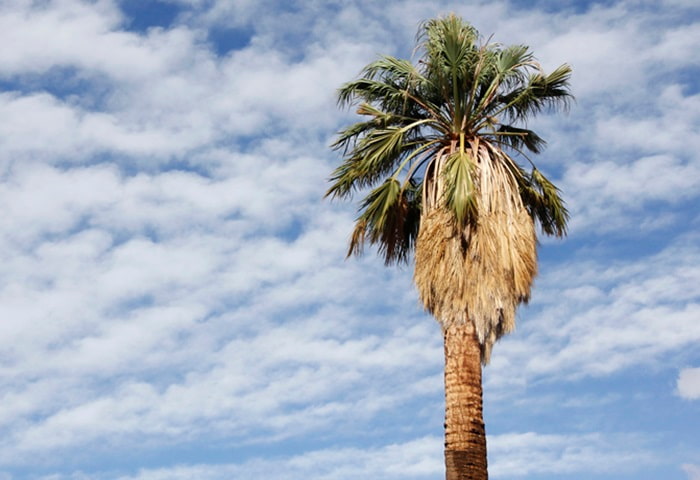 W. filifera Growing in Joshua Tree National Park, California
W. filifera Growing in Joshua Tree National Park, CaliforniaMexican Blue Palm - Among the Best Types of Arizona Palms
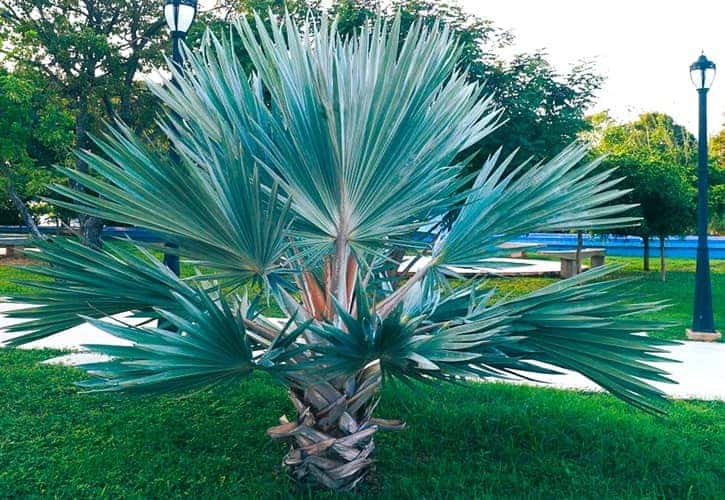 Photo: RJ Castillo - CC BY-SA 4.0
Photo: RJ Castillo - CC BY-SA 4.0Brahea armata is also called the Blue Hesper Palm.
With its gorgeous round crown of bluish-tinged fan leaves, it maxes out at 60ft/18m. Its long inflorescences, the flower stems, branch outward gloriously amidst the fronds.
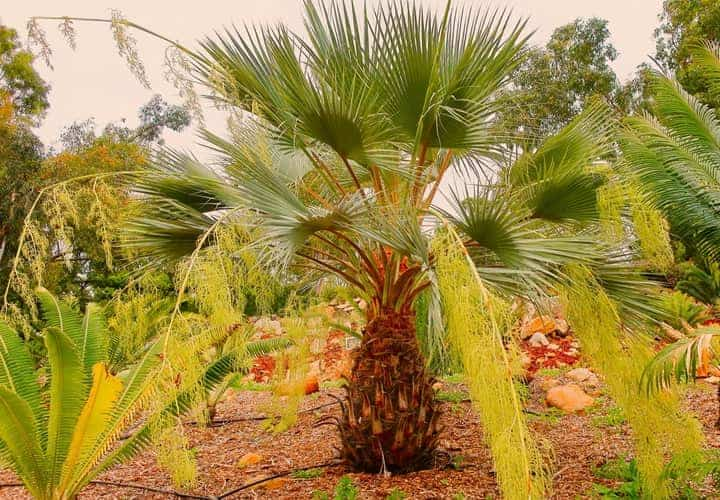 Magnificent Inflorescences Show Off - Even More Awesome as the Blue Hesper Grows.
Magnificent Inflorescences Show Off - Even More Awesome as the Blue Hesper Grows.Photo: KM @Flickr - CC BY 4.0
- In Arizona it's climate tolerance is for Zones 8b-11. It needs that full desert sun to avoid dulling fronds.
- Give it regular water which drains well through the soil. But when established, drought is tolerated.
- Use caution regarding the spiny petioles (leaf stems).
How the European Fan Palm Will Work in an Arizona Landscape
Chaemerops humilis is also called the Mediterranean Fan Palm. You might imagine it originates from coastal areas & islands of the Mediterranean Sea.
Different from those mentioned above, as it usually spreads out as a clumping palm (sometimes solitary, though, with one trunk). So in its clustering form it looks like a palm bush. However it grows, it's short, only to 30ft/9m at its peak.
- For Arizona deserts, it does well in Zones 8-11. It is a relatively slow-growing palm.
- Not particular about the soil, or about water timing. It is drought-tolerant. Give it some extra water & it will grow faster.
- The trunk has a matte of fibers & keeps its old leaf bases.
Bismarck Palm - How this Ashen Grayish Green Fits Arizona
Bismarckia nobilis is a stunner with its full crown of dusky green fan palms.
As a Madagascar desert palm, it's ready for planting in Arizona. Zones 9b-11; with care 9a can be tried.
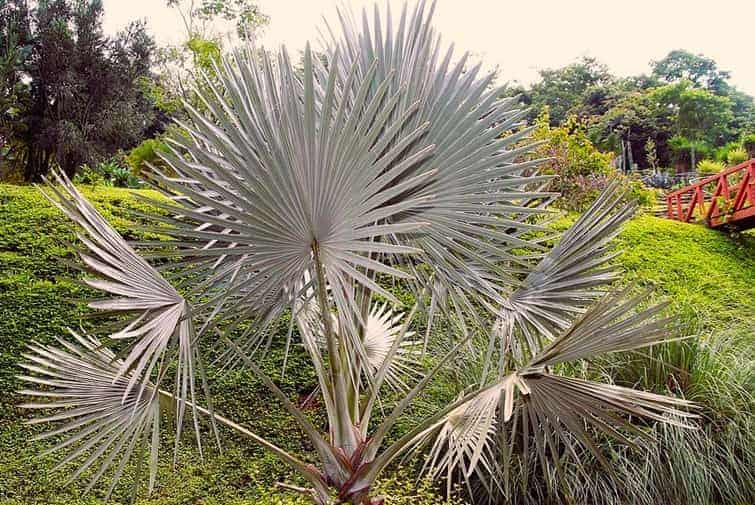 A Young Bismarck Palm, Just Beginning its Upward Growth
A Young Bismarck Palm, Just Beginning its Upward GrowthPhoto: David J Stang - CC BY-SA 4.0
- Can grow pretty fast, to 60ft/18m, so be careful of your placement.
- Loves that Arizona sun shining on all its Palmy Parts! Once firmly with you, it can take a little drought, too.
- Good for any type of soil, but add in some humus to keep it happier.
Wild Date Palm - This Phoenix Plant for Arizona is a Keeper
Phoenix sylvestris, aka Toddy Palm.
It resembles a smaller version of Phoenix canariensis, with an even thicker crown. It's generally a favorable Phoenix species for Arizona. Good for Zones 9-11. Worries would be its slight susceptibility to lethal yellowing & Graphiola false smut.
- Doesn't need a lot of water, but regularly give it a bit more & it responds by speeding up its growth.
- Can easily be started by seed.
- It wants that full Arizona sun! 🌞
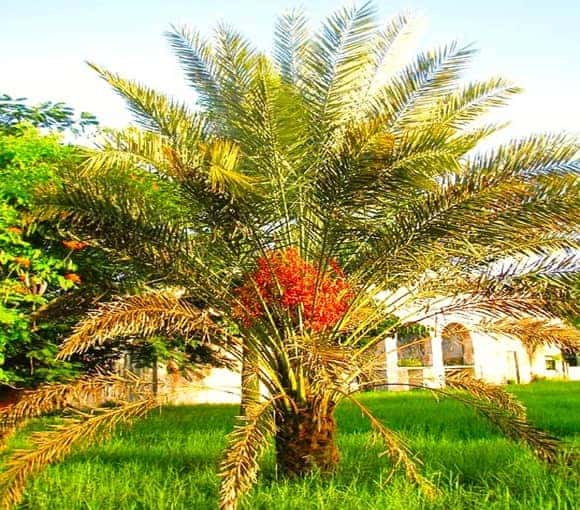 The Toddy (a source for a wine) - Wild Date Palm
The Toddy (a source for a wine) - Wild Date PalmCretan Date Palm - One Best Phoenix for Dry Climates
Phoenix theophrasti has its good points.
Originating from Eastern Europe near springs & intermittent streams. A clustering sort, up to 60ft/18m tall. Watch out for the orange, lower leaflet tip spines.
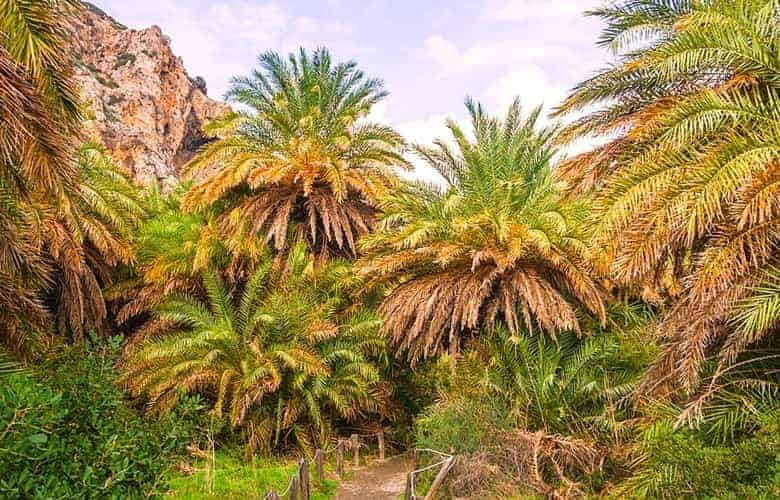 Grove of Cretan Palms in Preveli Palm Forest, Crete. They all survived a devastating 2010 fire! Photo: C Messier - CC BY-SA 4.0
Grove of Cretan Palms in Preveli Palm Forest, Crete. They all survived a devastating 2010 fire! Photo: C Messier - CC BY-SA 4.0There is a slight worry for lethal yellowing. But why is it among the best palm trees for Arizona?
- In the Arizona deserts, it's good to go for Zones 8-11. And loves the sun.
- No fussiness about soil, with low water needs.
- Quite easily grown from seed. It has some variants.
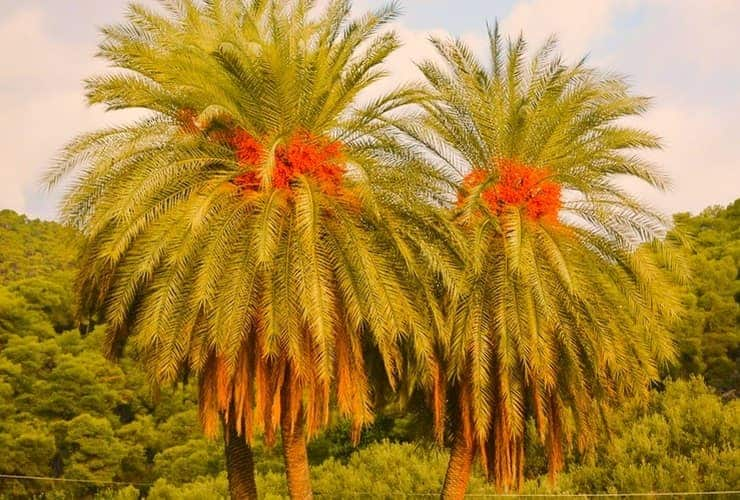 Here's a variant of the Cretan Palm: Phoenix theophrasti var. Epidaurus
Here's a variant of the Cretan Palm: Phoenix theophrasti var. EpidaurusAshley Basil @Flickr - Attribution 4.0 International
Be Cautious in Considering These Palms for Arizona
Some palms are widely seen throughout the Arizona desert. But there are more drawbacks for some than those above.
QUEEN PALM:
Syagrus romanzoffiana, which has been hybridized with the Pindo to create the Mule Palm, Mentioned Above. Some think it's suitable for Arizona. But really - do you want this?
- Quickly grows tall, providing very messy fruiting. Lots of them fall to the ground. With tons of seeds that sprout easily on their own.
- It's very thirsty - remember Arizona's water supply isn't ample.
- After 10 years of life, it gets quite scraggly looking.
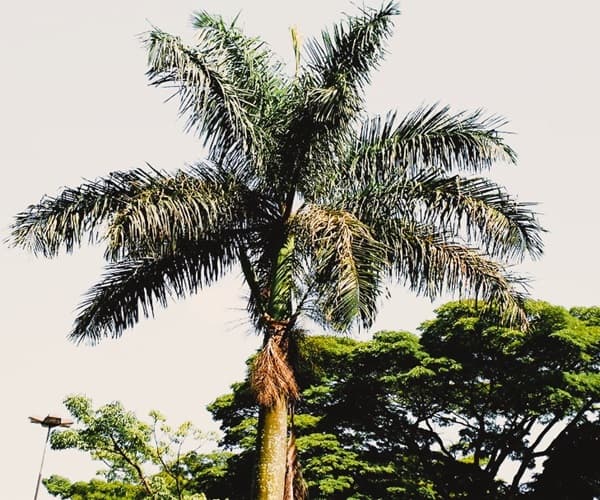 A Queen in Ceret Park, Tatuapé, Sao Paulo in its Native Brazil
A Queen in Ceret Park, Tatuapé, Sao Paulo in its Native BrazilPhoto: Mauro Halpern - Attribution 4.0 International
DATE PALMS: The Phoenixes have some knock-out looks. Consider their problems, if you're planning any for Arizona.
Phoenix dactylifera, the Edible Date Palm may be acceptable, if you're okay with heights of 90ft/27m. They're grown commercially in Arizona: Yuma & Dateland. Perhaps even more areas. They do well in Arizona Zones 7b-11. You'll have the benefits of your own true date palm fruits. However...
- The lowest pinnate fan-like leaflets have spiky tips. Ouch!
- A small danger is they can get Lethal Yellowing. Not fun, after the investment.
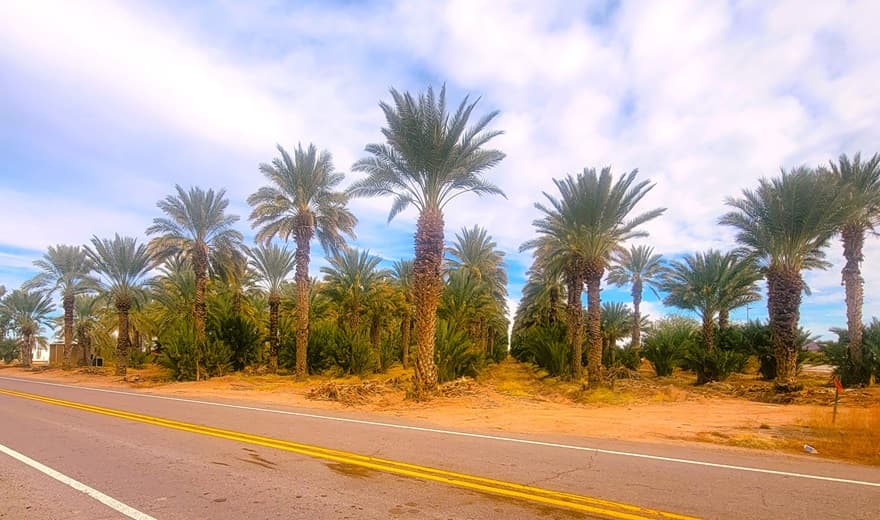 Commercial Grove of Phoenix dactylifera in Dateland, AZ
Commercial Grove of Phoenix dactylifera in Dateland, AZPhoenix canariensis, the Canary Island Date Palm is stunning with its round crown.
When young it has a pineapple look. People often call it the Pineapple Palm. They're in many front yards of Tucson homes. But the drawbacks...
- Most successful, with proper care, only in USDA Hardiness Zone 8b.
- Leaflets turn from green into orangey spines on the lowest feather fronds.
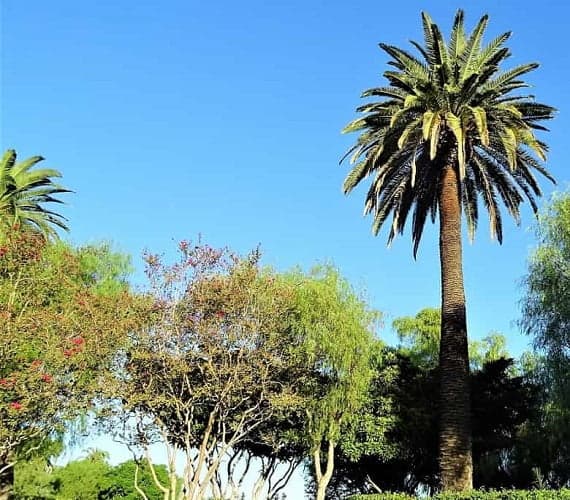 Canary Island Palm with a Full Crown & Thicker Trunk
Canary Island Palm with a Full Crown & Thicker TrunkPhoenix reclinata - Senegal Date Palm is a handsome species.
They cluster, with tall trunks going skyward. Trouble is...
- At the oldest fronds, the lowest leaflet tips turn into the most ruthless spikes. Not nice, when they're at the bush-like level! 😮
- They do require some good amount of watering. We don't generally go for that in AZ deserts.
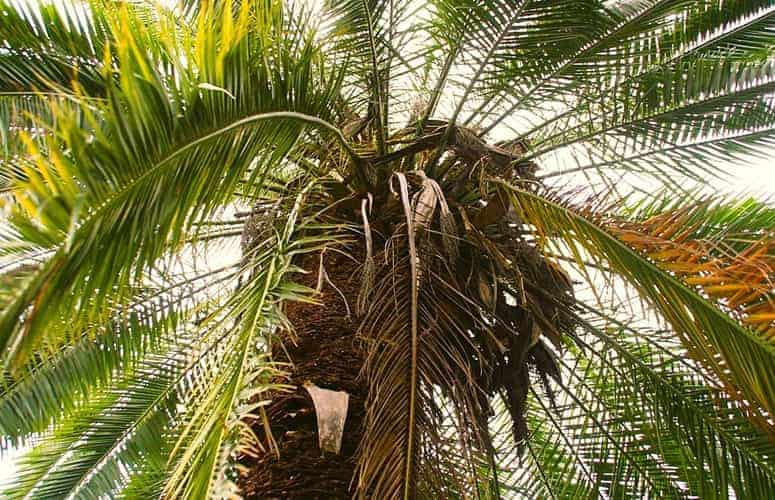 Looking Up Into the Crown of the Senegal Date Palm - Photo: David J Stang - CC BY-SA 4.0
Looking Up Into the Crown of the Senegal Date Palm - Photo: David J Stang - CC BY-SA 4.0Phoenix roebelinii, called the Miniature Date Palm & the Pygmy Date Palm. This one I've really liked, when I've seen them here & there around Tucson. Which is Zone 9b. In fact our neighbor has a wonderful one growing out front. Yet what's the problem?
- Mainly, it has high water requirements. Since it's origin is from Southeast Asian riversides.
- As with Phoenixes, it does have those spiky leaflet tips.
Phoenix rupicola - Cliff Date Palm has a looker advantage. But beware...
- Its nourishment needs are particular: lots of water & needing organic additives for soil.
- There's a small chance it may contract lethal yellowing.
- It would need lots of nurturing in Zone 9b, but not suitable for cooler zones at all.
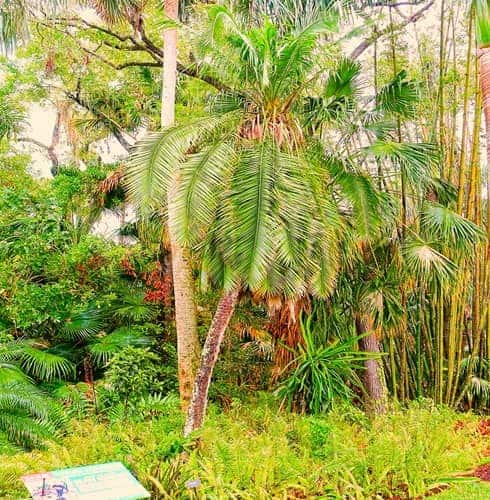 Phoenix rupicola in McKee Botanical Garden
Phoenix rupicola in McKee Botanical GardenBest Palm Trees for Arizona Takeaways
So, if you're planning to transform your landscape, by planting a palm and maybe other tropical plants - use our recommendations for the Best Palm Trees for Arizona. Because for success, it's best to remember the gardening rule: the right palm planted in the right place.
Then you'll be able to make your garden a luscious, aromatic tropical look. Isn't that a fantastic plan, and an inviting prospect?
